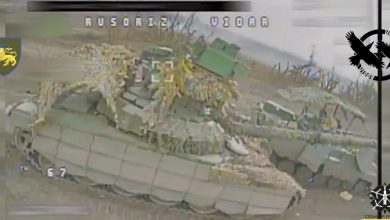Boeing spacecraft will fly 2 NASA astronauts despite plane mishaps
NASA’s Butch Wilmore and Suni Williams are scheduled to board Boeing’s CST-100 Starliner spacecraft Monday evening, blast into the sky and cruise around Earth until the spacecraft docks with the International Space Station early Wednesday.
They are expected to live on the space station for about a week, then brave a fiery fall back to Earth with the spacecraft deploying parachutes to land in the southwest United States.
NASA astronauts Butch Wilmore and Suni Williams conduct adapted operations in the Boeing Starliner simulator at NASA’s Johnson Space Center. NASA/Robert Markowitz
This crewed flight test mission lasts more than a decade. Starliner is finally catching up to SpaceX’s Crew Dragon, which has been working overtime to ferry astronauts to and from the ISS for NASA while Boeing lags behind.
Boeing might be on your mind for another reason, however. Its latest string of passenger jet woes began in January, when a group ripped apart a Boeing 737 Max 9 jetliner. shortly after taking off from Portland. Several people were injured, but fortunately no one was in the seats next to the gaping hole that opened up on the plane.
The hole where a panel tore off the side of a Boeing 737 Max 9 jetliner shortly after it took off from Portland in January. NTSB/AP
Then Alaska Airlines and United Airlines both reported parts on their grounded Boeing planes. The Federal Aviation Administration launched a six-week audit of Boeing and its supplier, Spirit AeroSystems, while the Justice Department opened a criminal investigation.
Does all this affect the safety of astronauts aboard the Starliner?
“It’s a clean spacecraft and it’s ready to launch. And I can tell you that from NASA’s point of view, we won’t launch it until it’s ready,” the chief said Friday. of NASA, Bill Nelson, to journalists.
NASA now clearly trusts the spacecraft, but there have been problems.
During its first attempt to fly to the ISS uncrewed, in 2019, a software error caused the spacecraft’s fuel to burn shortly after launch, forcing an early return to Earth. Dozens of other problems were discovered during this flight. Then, a problem with the propulsion system’s valves delayed his second attempt, which eventually reached the ISS.
In the eyes of some aerospace experts, aircraft issues are not entirely irrelevant.
The Boeing Starliner spacecraft is lifted to the Space Launch Complex-41 Vertical Integration Facility, where it will be stacked atop an Atlas V rocket for its first crewed flight, at the Cape Canaveral Space Station in Florida . NASA/Kim Shiflett
“I really don’t think there’s a single direct link,” George Nield, former associate administrator for the FAA’s Office of Commercial Space Transportation, told Business Insider.
“It’s different people, different missions, and even different cultures, probably within these units,” he added. “But at the same time, senior leaders have a very important role to play in establishing the overall safety culture, in setting the overall priorities, and in setting the expectations for speaking up. “
In response to a request for comment, a Boeing spokesperson referred BI to four of the company’s public Starliner press briefings with NASA. The spokesperson did not specify which comments during the briefings were relevant.
Boeing Safety Culture Concerns FAA, NASA
The FAA investigation found dozens of manufacturing problems at Boeing and its supplier, including inconsistencies in employees’ understanding of quality control and procedural problems at the factory, the New York Times reported.
An expert panel also reported “a disconnect between Boeing’s senior management and others in the organization when it comes to safety culture,” as well as doubts about whether the company’s safety reporting system company “guarantees open communication and freedom from retaliation.”
Bjorn Fehrm, an aviation industry analyst at Leeham Company, says Boeing’s problem is its history of focusing on key performance indicators, or KPIs.
“It changes the criteria for advancement in the company,” Fehrm told Business Insider. Rather than being a good engineer, he says, KPIs provide incentives to become a good politician. They make shareholders happy, but they do not always result in the best product.
The Alaska Airlines plane’s malfunction is “a symptom of the disease,” Fehrm said. “The disease is 25 years of culture that prioritizes numbers over the best knowledge of what to do.”
This culture is also to blame for two fatal 737 Max plane crashes in 2018 and 2019, Fehrm says.
NASA also investigated Boeing’s corporate culture after the error-riddled 2019 Starliner test flight. Doug Loverro, a NASA associate administrator who oversaw the program at the time, said the two fatal 737 Max crashes were on his mind when he launched this investigation.
Ethiopian police officers walk past the debris of the Ethiopian Airlines plane ET 302 crash. REUTERS/Baz Ratner/file photo
After these disasters, Boeing hired a new CEO and board members with engineering backgrounds and created an aerospace safety committee.
These are certainly improvements, Fehrm said, but it doesn’t change the middle management that filtered through adopting the KPIs.
“The desire to increase the production rate as much as possible is still there, and the old habits of cutting corners in order to shape the numbers are still there,” Fehrm said.
“Boeing’s culture is that of an oil tanker. It’s a ship,” he added. “You can only turn so fast.”
Spaceflight is riskier than aviation
Hazmat teams work around Boeing’s Starliner spacecraft after it lands at Space Harbor at White Sands Missile Range in New Mexico, ending its second uncrewed orbital flight test. NASA/Bill Ingalls
NASA and Boeing have calculated the probability that a catastrophic accident will result in the death of astronauts during a Starliner flight – euphemistically, they call this scenario “crew loss.”
NASA’s minimum requirement for crew safety was a 1 in 270 chance of losing a crew. Boeing topped that figure with 1 in 295, according to Steve Stich, who manages NASA’s commercial crew program that gave birth to Starliner. He added that these calculations are for a full 210-day mission, while Whilmore and Williams’ test flight lasts only a week.
Of course, such probabilities would never hold for commercial aircraft.
Spaceflight is much more dangerous than aviation, in part because they are much younger. For more than 100 years, humans have been building and flying airplanes, making deadly mistakes and learning from them.
The United States has conducted about 400 crewed spaceflights, and four of them resulted in fatal malfunctions, according to a 2020 analysis. This represents a fatal failure rate of 1%, or 10,000 times higher than that of commercial airliners.
Spaceflight involves extreme environments and powerful rocket engines. There are simply more dangers the further you go from the ground.
“Even after many years and hundreds and thousands of airplane flights, we still need to have a healthy safety culture. And this same situation applies even more to space activities,” Nield said.
Starliner has additional safety features
Starliner’s flight Monday is a test, and the spacecraft has already undergone a rigorous testing process at the request of NASA.
Boeing fired the spacecraft’s thrusters to the ground, tested its parachutes, launched it and immediately aborted in order to test the mechanism that would jettison the spacecraft away from a failed rocket. Boeing also made a series of reviews and fixes to address issues discovered during its two uncrewed flights.
The astronauts played a very concrete role.
“We have our fingerprints on every procedure that exists for this spacecraft,” Wilmore told reporters during a question-and-answer session Wednesday.
Starliner also incorporates additional safety measures into its design, Whitmore and Williams said during the question-and-answer session.
For one, there are no “black zones” – parts of the flight path where a certain type of spacecraft failure would be impossible to survive. This is due in part to its unique ability to switch between three different flight modes: fully automatic, manual control with computers, and a fully manual backup mode without a computer, as a failsafe.
Starliner can also abort its flight anywhere from the launch pad “all the way to orbit,” Williams said.
“We are in the high range, so we will be fine,” she added.
businessinsider




